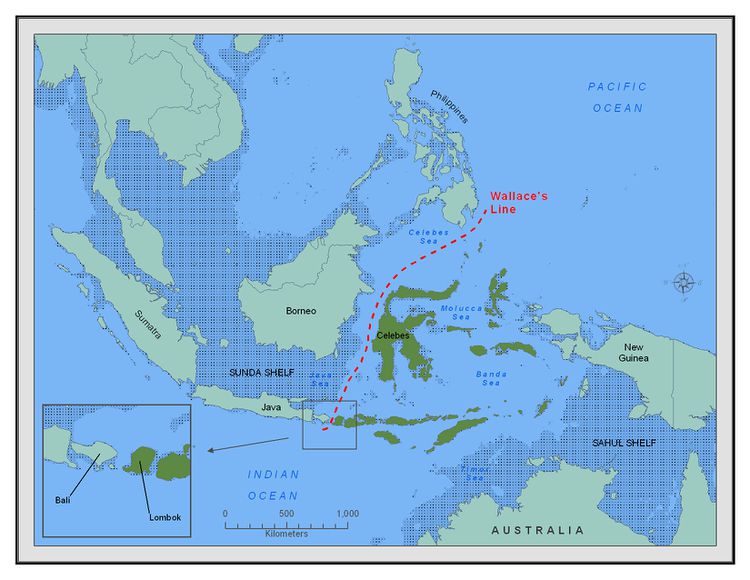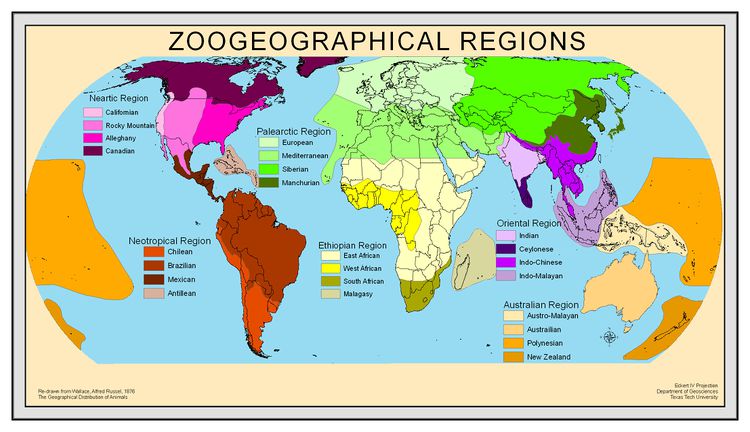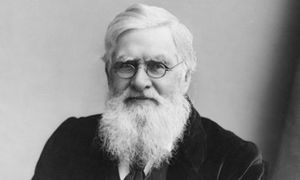Wallace, Alfred Russel
Alfred Russel Wallace (1823-1913) is best known for introducing natural selection as the driving mechanism of evolution, independently and contemporaneously with Charles Darwin. In addition, he is the most influential of the founders of the field of biogeography. While often regarded today as a footnote in discussions of Darwin, during his life, Wallace was one of the best-known scientists and public intellectuals in Victorian England.
Contents
Early life
Wallace was born in Wales, the fifth of six children. His father trained as a lawyer, but lived largely off of a modest inheritance. Over time, though, marriage and a growing family forced him to work at a variety of mostly poorly paid jobs. The family moved frequently around Wales and southern England. They did, however, have many books and while Alfred grew up with little money, he read much and was encouraged in intellectual pursuits. His formal education ended at age fourteen, but as a teenager he attended lectures at “Mechanics Institutes,” which provided evening lectures to working class people interested in educating themselves. He felt that on important matters, he was mostly self-educated.
When his formal schooling ended, Alfred was sent to live with a brother in London, where he apprenticed as a surveyor and worked at that profession for much of the next six years. He worked in many different parts of England and Wales and began a hobby of collecting the local plants wherever he happened to be. Also in his spare time, he read much, especially natural history and travel books, including works by geographer Alexander von Humboldt, geologist Charles Lyell, and Charles Darwin. And he began to think about the means by which species originate.
South American explorations
Wallace met Henry Walter Bates at a library and the two became friends over their shared love of natural history. Bates had an impressive collection of beetles and butterflies. The two decided to become professional collectors, supporting themselves by selling specimens to museums and private collectors and they chose the Amazon Basin as their first destination. After finding an agent to sell their plant and animal specimens, they set sail for Brazil in 1848.
Wallace and Bates began at the city of Pará (now Belém), near the mouth of the Amazon River. They collected insects, birds, mammals and plants and sent them back to England. Slowly they gained experience in travel and after nine months they decided to split up, though it is not clear why they separated. Soon after, Alfred’s younger brother Herbert joined him and they occasionally met up with Bates. Whenever possible, they travelled with traders and were able to stay in towns. And, typically, they found local people to help them in their collecting.
After two years in Brazil, Wallace set off up the Rio Negro, making it into Venezuela. He went without Herbert, who decided that natural history was not his calling in life. In addition to collecting, Alfred began to plan for a series of scientific and travel writings to be done when he returned to Europe. He was trying to understand the distribution of species and noted, for example, that species were different on the North and South sides of the Amazon, as though the river itself was a barrier to dispersal.
While Alfred was out, Herbert prepared to return to England but caught yellow fever and died. Bates happened to be with Herbert at the time and nursed him as best he could. Bates, too, caught the disease, but survived. It was months before Alfred learned of his brother’s death, during which time he suffered a debilitating fever and was lucky to have survived himself.
(Bates stayed in the Amazon for eleven years and became one of the world’s leading entomologists. Long discussions between Wallace and Bates in the Amazon likely helped Wallace refine his ideas on evolution. The two remained friends, though not close friends, for life. Today, Bates is best known for “batesian mimicry,” where a harmless species, usually an insect, will evolve to imitate a dangerous species, so that predators avoid the harmless one.)
Wallace set sail for England after four years in the Amazon. He carried his most recent collections with him, but lost virtually everything when the ship caught fire at sea. They were rescued by another ship, but he had a miserable crossing to England, with poor food and sickness much of the way. Fortunately, his agent had insured the collection for £250, so he was not destitute when he arrived home.
Malaysia expeditions
Wallace introduced himself to the scientific establishment in England and soon began planning for his next collecting expedition. He attended meetings of various natural history and geographic societies and presented several papers. He wrote two books, one on palms and one on his travels, but neither earned him much of a profit. He chose Malaysia as his destination and learned what he could of its natural history and geography from books and museum collections. He set sail in 1854, with Singapore as his first home base. This expedition lasted eight years.
Alfred’s first major collecting trip in the region was to Borneo. Unable to do much collecting during the rainy season, he wrote up his thoughts on how species originate. His first paper on the topic summarized existing theories and used his own observations to evaluate each one. It attracted some attention in England, though Darwin wrote in the margins of his copy “nothing very new.”
Back collecting, Wallace noted that the islands of Lombock and Bali are similar in most ways and very close to each other, yet are quite distinct, zoolologically speaking. Lombock has mostly Australian fauna and Bali has mostly Asian species.
A correspondence began between Wallace and Darwin in 1855, with Darwin requesting specimens for his studies. Friends of Darwin presumably encouraged him to read Wallace’s paper on evolution more carefully and notice that the two were working along similar lines. Darwin made Wallace aware that he had been working for twenty years on a theory of how species originate. Wallace replied that he was preparing a major work on the topic, but it would not be completed for some time.
On a collecting trip in the Moluccas in 1858, however, Wallace came down with malaria and while recovering, remembered reading Thomas Malthus’s essay on “Principles of Population” a dozen years before. He suddenly saw that Malthus’s explanation for controls on human population, such as war, famine and disease, could be extended to animals. He realized that the best adapted individuals produced the next generation, resulting in a change in a species over time. In addition, as the environment changes in both space and time, species will change accordingly. Wallace was convinced that he found the explanation for the origin of species. He later commented that this insight hit him much as it had Darwin twenty years earlier. Darwin, too, developed his theory after reading Malthus.
Wallace quickly wrote up his ideas and sent them to Darwin. He then headed for New Guinea for more collecting. Darwin read the paper and it was obvious that Wallace and he shared the same theory, the one Darwin slowly developed over two decades. He sent Wallace’s letter to Charles Lyell, explaining that it should be published even though Wallace did not request that it be submitted for publication. Lyell suggested that Darwin and Wallace should publish simultaneously. Darwin, grieving over the death of a son, let his friends Lyell and Joseph Hooker deal with the problem. At a meeting of the Linnean Society in 1858, extracts were read from an unpublished 1844 essay by Darwin outlining his theory. Then part of a letter Darwin wrote in 1857 on his theory was presented. Finally, Wallace’s letter to Darwin was read. In this way, the two men could share in the credit for the theory. Darwin did not attend as his son was buried that day. Wallace, of course, was not present and was unaware of the event.
When Wallace received letters from Darwin and Hooker explaining what had been done with his letter, he was thrilled. He later wrote that he was honored to be included with Darwin and that his work contributed to Darwin’s completion of his great book on the topic. Darwin sent him a copy of “On the Origin of Species” when it was published and Wallace read it many times with great admiration for both the book and its author.
Return to England and biogeography publications
In 1862, after nearly eight years in Malaysia, Wallace returned to England. It took some time for him to recover his health after so many years of physical exertion and numerous tropical diseases, but he became active in several scientific societies and began to publish papers on a variety of subjects.
Alfred met and fell in love with Annie Mitton and the two were married in 1866. He was forty-three and she was twenty and they had a long and happy marriage. They had two sons and a daughter, but the eldest son died at age six. Family obligations and poor investments left Wallace scrambling for money. He began working on a book on his Asian travels and “The Malay Archipelago” was published in 1869. It sold well and helped his financial condition somewhat. The book was dedicated to Charles Darwin.
In 1865, Wallace became interested in spiritualism, a common topic of the day. He began attending séances where, presumably, spirits of the dead would, for example, cause tables to rise up and rapping sounds would send messages to the living. He knew that some mediums were frauds, but he was convinced in his scientific mind that here is an unknown reality shown by ‘legitimate’ spiritualists. Wallace’s grieving over the death of his eldest son was somewhat consoled by his belief that his son’s spirit would live on. He invited many of his scientific friends to experience séances firsthand, but most refused his invitations to partake in what is now called a pseudoscience.
Wallace began to write about human evolution. He argued that people are advancing toward a “perfect social state” with much individual freedom and self-government. Many of the peoples he encountered in his travels, he felt, were closer to this ideal than Europeans, who failed to emphasize moral development. He also argued that human evolution is distinct from the rest of the living world. He had no doubt that humans and apes are closely related, but certain aspects of people could not have developed by purely natural means. Moral and intellectual development, especially, are too advanced to be explained by natural selection alone. Along the lines of his spiritual beliefs, he felt that some “higher intelligence” must be involved. He had, much earlier, rejected standard Christian doctrine and argued that poorly understood powers are at work. Darwin adamantly disagreed with Wallace that natural selection alone is insufficient to explain human evolution, but the two remained friends.
Wallace wrote scientific papers and also wrote for the popular press on a wide variety of subjects, mainly for the small income he received for each article. Money was in short supply because he had no full time job. Darwin convinced many leading scientists to support a petition for the government to give Wallace a pension for his contributions to science. He was given £200 per year, a supplement to his income that significantly eased his financial pressures.
His major scientific contribution of the 1870s is the two-volume “Geographical Distribution of Animals” where he pulled together his ideas on the topic that began in the Amazon. He discussed the factors that make one biogeographic region different from another and the effect of the geological past on present animal distributions. The work was well received and is considered the first major work on animal geography. Alfred realized that, with respect to animals, there are “Asian” islands and “Australian” islands in Malaysia, with a distinct line separating the two, as he first noticed on Bali and Lombock. Mammals, for example, are mostly marsupials on the Australian side of the line. (Thomas Henry Huxley apparently coined the phrase “Wallace’s Line.”) A second biogeography book soon followed, called “Island Life,” where he discussed, for example, the degree of isolation and its effects on the biology of islands.
Later years
Charles Darwin died in 1882. Wallace joined other scientific luminaries as a pallbearer at the funeral in Westminster Abbey.
Wallace did little new science in the 1880s. Instead, he focused his energies on the socialist agenda pertaining to land reform. He was introduced to socialist thinking in his youth, especially the Mechanics Institutes lectures he attended. He argued that the land should be owned by the state, though individuals could own buildings and other improvements. If the poor were given access to a small plot of rural land, he felt, poverty would be greatly reduced. He also continued to promote spiritualism and was a leader in an unsuccessful fight to discredit vaccinations as an effective means to reduce disease.
In 1886, Wallace began a lecture tour of North America, mainly done to make money. His talks on a variety of topics, mostly related to his travels and science, were well received. He met with the spiritualist community in the United States and was duly impressed. One séance he attended moved him, but soon after the medium was shown to be a fraud. He refused to accept that he had been fooled and publically defended her. He traveled across the United States giving lectures, viewing the scenery, and collecting specimens, mostly of plants. He spent time with a brother who had moved to California during the Gold Rush, about the time Wallace went to the Amazon. He finished his tour in Canada and was glad to be home after nearly a year of travel.
In 1889, Wallace published “Darwinisn,” his opus on evolution. In it, he explained his views on the subject, including his controversial ideas on human evolution.
The fiftieth anniversary of the readings of Darwin’s and Wallace’s papers on natural selection was celebrated at the Linnean Society in 1908. Wallace spoke and received a gold medal with his image on one side and Darwin’s on the other. Also that year, he received the Copely Medal from the Royal Society of London, the most prestigious award given to a scientist in England, and “The Order of Merit,” by the King for distinguished service by a member of the British Commonwealth.
Wallace died at home in 1913 at age ninety. He continued writing books and articles on scientific, social and spiritual topics to the end of his life.
The legacy of Alfred Russel Wallace rests mainly in his contributions to theories of evolution and biogeography. His years of intensive empirical research provided the background that allowed him to develop powerful theories of how the world works. His forays into spiritualism and aspects of human evolution involving a “higher intelligence” suggest an independent mind willing to pursue scientifically unpopular issues. That he was unable to convince his peers that he was correct shows the strength of the communal nature of science.
 Map of Malay Archipelago, showing Wallace’s Line and Wallacea (dark green). Stippled pattern in ocean indicates less than 120 meters deep and, hence, dry land occasionally during ice ages. Darker islands are grouped as “Wallacea.” (Wallace adjusted the position of the line so that Celebes is on the Asian side in 1910.) (Map by Chris Van Nice.)
Map of Malay Archipelago, showing Wallace’s Line and Wallacea (dark green). Stippled pattern in ocean indicates less than 120 meters deep and, hence, dry land occasionally during ice ages. Darker islands are grouped as “Wallacea.” (Wallace adjusted the position of the line so that Celebes is on the Asian side in 1910.) (Map by Chris Van Nice.)
 Zoogeographic regions of Earth's land areas, according to Wallace (1876). (Map by Colin Carsrud and Chris Van Nice.)
Zoogeographic regions of Earth's land areas, according to Wallace (1876). (Map by Colin Carsrud and Chris Van Nice.)
One sign of the contributions of a scientist is the number of ideas and things named for him or her. Wallace has three such eponyms:
Wallacea is a biogeographical region in Indonesia comprised of islands that are separated from the continental shelves of Asia and Australia by deep water and, therefore, are more biologically isolated than islands on the shelves. The Philippines sometimes are included in Wallacea.
Wallace’s Line (sometimes referred to as Wallace Line): West of this line are mostly Asian species and east of it are species associated with Australia and New Guinea. During periods of low sea level associated with ice ages, the islands on the west side of the line are connected to Southeast Asia. Wallacea is on the Australian side of Wallace’s Line, partly due to a similar geological history.
The Wallace Effect is the idea that reproductively isolated populations may become separate species by natural selection acting to reduce the number of viable hybrids between the two. For example, the flowering time of two groups may differ sufficiently over time so that no interbreeding is possible.
Further reading
- Raby, Peter. 2001. Alfred Russel Wallace: A Life. Princeton University Press, Princeton, 340 p. (the main source for this article)
- Shermer, Michael. 2002. In Darwin’s Shadow: The Life and Science of Alfred Russel Wallace. Oxford University Press, Oxford, 422 p.
- Smith, Charles H., and George Beccaloni. 2008. Natural Selection and Beyond: The Intellectual Legacy of Alfred Russel Wallace. Oxford University Press, Oxford, 482 p.
- Wallace, Alfred Russel, 1962. The Geographical Distribution of Animals. Hafner Publishing Company, New York. (Reprint of the original 1876 edition, in two volumes.)
- See also, Charles H. Smith’s The Alfred Russel Wallace Page: http://people.wku.edu/charles.smith/index1.htm
